John Herald
Just Another Bluegrass
Boy
(2005)
| "I have never
stopped writing songs because when you get towards
the end and you know that it's going to be a finished song it's very
exciting, one of the most thrilling things that can be done and one of
the most artistic things you can do as a
musician..." |
|
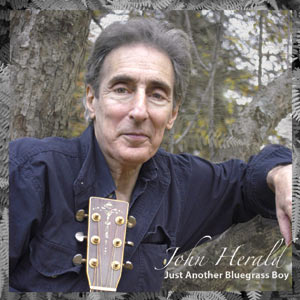 |
John said he had to work hard at writing songs. And his performances
were so dynamic, so electrifying, that he always thought he had to
give that same sort of thing on record. It was only toward what
turned out to be the end of his days that he could be convinced and
cajoled into the confidence to put out this set of him singing only
his own songs. But for those who knew him and his music, this was the
record we all wanted him to do. And, it really wasn't a new idea to
him. Indeed, he had been planning the project over a number of years,
gathering the recordings from the sessions that he liked, sorting
through the songs he wanted to present. John died before it was
finished, though. And thus it fell to those of us who were helping
him to make the final choices and get it done.
 |
Listen to Samples
 |
Jon the Generator |
 |
Hats Off to the Cajun Moon |
 |
Working It Out By Walking It Off |
|
 |
But John also wanted the chance to tell some of his story.
Oh I thought that when I left my home I was a man of some reknown
But in old New York I was on the walk,
Just an ordinary fool from a one horse town,
just another bluegrass boy
Despite those lyrics, John Herald was not a fool from a one horse town. He was a New Yorker.
Let's just let him tell it.
"I'll just start from the beginning," said John, in about four hours
of interview we did for these pages.
"I was born in 1939 on Grove Street in Greenwich village. My father
was a bohemian poet, Leon Serabian Herald. You wouldn't know him
unless you looked in literary magazines of the 20s, 30s and 40s, he
was published in all the periodicals of the day. So he had a lot of
colorful characters around the house, poets, painters, sculptors.
Kenneth Fearing, who was considered one of the Village top of the line
bohemian poets, was my father's best friend and he lived about four
blocks from us. My mother died when I was three and after she died it
took the inspiration away from my father's poetry. From three to
eight - five years - I was in five different foster homes. But if I
expressed any unhappiness, my father would take me out. When I was
nine, I went to a progressive boarding school, started by a fellow
named Scott Nearing, who wrote books about the back to the Earth
movement.
"We moved to the east border of Greenwich Village. We lived on 13th
Street and 3rd Avenue. That's where life started getting really
interesting. We lived on the third floor. At the time it was the
Bowery we lived on. There was nothing there but bar, bar, bar, pawn
shop, pawn shop, flop house, flop house. They had an elevated train
which ran the length of the third floor where we lived. So I could
see into the trains. Because of the Third Avenue el, it made it kind
of dark. It was not that far from the second world war and there were
a lot of places where derelicts went to drink, Bowery places.
"One day, when I was 16, my father took me to Washington Square Park
on a Sunday. For a few years before that they would allow folksingers
and bluegrass singers to pick in Washington Square Park from noon to
six at night. I would go down there and meet a couple of friends from
camps where I went in the summer.
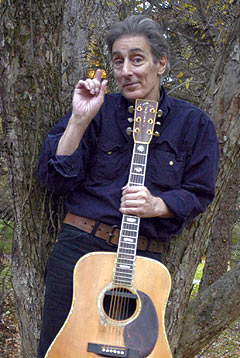 "Pete Seeger had come to one camp, Woodland, which is up in Phoenicia.
He said, well I don't care if you can't carry a tune with a
wheelbarrow, just let loose and you might be singing in a harmony, it
doesn't matter. I didn't know much about folk music at the time. I'd
heard about it, my father had taken me to different functions at which
I'd heard Leadbelly and Woody Guthrie.
"Pete Seeger had come to one camp, Woodland, which is up in Phoenicia.
He said, well I don't care if you can't carry a tune with a
wheelbarrow, just let loose and you might be singing in a harmony, it
doesn't matter. I didn't know much about folk music at the time. I'd
heard about it, my father had taken me to different functions at which
I'd heard Leadbelly and Woody Guthrie.
"Pete was trying to get us to sing, but finally we did start singing
and I heard my voice sort of soaring above everybody else, I had a
really high voice and it was like a thrill. And that's where I found
out that I just love singing, it was like an epiphany. I didn't know
if I was a good or bad singer, I just knew it was fun.
"So at Washington Square, one of the first people I saw after I
started going there by myself was a fellow named Roger Sprung, a very
imposing fellow. Extremely tall and my friends from camp kept nudging
me to ask Roger if I could sing a song. Finally after about two or
three Sundays I worked up enough nerve, and he said 'well, can you
sing, kid?' and I said well I really don't know, so he didn't say
anything, and finally he said, well you want to try a song? I said,
yeah but I was very timid. So I started singing and I got through and
he said, hm, not bad. And then he waited a few more songs and asked
me to sing again. Then I started coming down and he was on me all the
time and he wanted me to be the lead singer in his coterie around
Washington Square.
"I'd see people down there that we know today, here in Woodstock,
Happy Traum, Eric Weissberg. Eric used to play with a fellow named
Marshall Brickman, who co-wrote movies with Woody Allen. And just by
chance I happened to go to the University of Wisconsin, unbeknownst to
me, with Eric Weissberg and Marshall Brickman. On my first day there,
I went to a freshman mixer, and Eric was walking out and I see him and
say, golly are you Eric. And he said yeah, and I said, I've been
watching you in Washington Square Park. He said really? Do you like
bluegrass? So we got over to his place and he handed me a guitar and
I said I don't play, I just love the music and can sing it a little
bit. At the end of the year, Eric showed me a couple of guitar
chords.
"So I went back home and persuaded my father to give me $30 for a
guitar. There was nothing but pawn shops where we lived and they had
every kind of guitar imaginable, from every country imaginable. You'd
go in and they had maybe 100 guitars. So I picked out a nice little
Gibson, not knowing anything about brand names, it looked nice and
sounded real nice. So I bought this guitar, took it home, played a
couple of guitar chords and it sent shivers up and down my spine and I
said, well that's the end of my schooling, I'm going to become a
guitar player. I knew my father was not going to be happy, but he
didn't come down on me hard, which was kind of surprising."
"So we started playing at Washington Square and we would get crowds
sometimes 15 people deep around us, so we knew that we were liked.
The second summer, when we were just deciding that we would form a
group, Eric Weissberg's mother came up with a name, The Greenbriar
Boys, which was quite catchy. A guy came up to us and said he was
from Vanguard Records and would give us a call to record. And we said
to ourselves, yeah, sure. But lo and behold, Maynard Solomon gave us
a call and we recorded on a quarter of a record, called New Folks and
Joan Baez somehow heard of it. We're talking 1957. By 1958, Solomon
wanted us to record our own record and Joan Baez heard that and wanted
us to record with her. So we recorded two songs with her on her
second album and then she wanted us to tour with her. So we went from
totally unknown in one year to playing in front of thousands of
people. We all loved her. To this day, I love her."
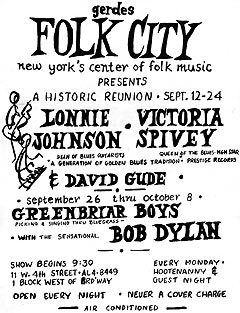 One story of John's at that time concerned Bob Dylan's famous review
in the New York Times, written by Robert Shelton, one of the key
launching points of his career. Seems Dylan was the opening act that
night for the Greenbriar Boys at Gerde's Folk City. The Greenbriar
Boys were asked if it was OK for Dylan to open their show.
One story of John's at that time concerned Bob Dylan's famous review
in the New York Times, written by Robert Shelton, one of the key
launching points of his career. Seems Dylan was the opening act that
night for the Greenbriar Boys at Gerde's Folk City. The Greenbriar
Boys were asked if it was OK for Dylan to open their show.
"By this time, Bob was a friend of mine, so I said fine. I wish he
would return the favor now. We could have said no to Dylan, but Dylan
would have ended up playing there with somebody. I liked Dylan quite
a bit, so that's how that happened. Anyway, Robert Shelton was the
critic for the New York Times, wrote an amazing review of Dylan saying
that Dylan was essentially going to be a star, going to go shooting
straight up from there, from Folk City."
Dylan has, in fact, visited John in Woodstock within the last decade,
to swap songs.
The Greenbriar Boys recorded three albums by themselves on Vanguard,
one on which they backed up singer Dian James, on Elecktra Records, as
well as on a 1959 collection called New Folks. In 1972, Vanguard put
out a Best of the Greenbriar Boys. The group went through personnel
changes, having included at various times Eric Weissberg, Bob Yellin
and Ralph Rinzler, Frank Wakefield. The band with Yellin and
Weissberg became the first touring bluegrass band made up of
northeastern people. They played the big folk festivals, Newport and
such, played on the Grand Ole Opry as substitutes for Flatt and
Scruggs, played at Union Grove, where they were introduced as the Jews
from New York; they toured with Johnny Cash, the Louvin Brothers and
Jim Reeves.
The group broke up in 1966, but The Greenbriar Boys, John, Yellin, and
Weissberg have done tours every 12 to 15 years since, playing the
Philadelphia Folk Festival, Champlain Valley Folk Festival and the
Lincoln Center Folk Festival.
And now I swim ashore, for I must make it
Although I'm up to my neck
In high muddy water
"I was introduced to Woodstock at the age of three. When my mother
was alive, they would come up and visit the Downers on Zena road.
When I got to be around 19 or 20 I would come to Woodstock and camp
out, maybe with a girlfriend. At 22 I started renting a cabin in the
summer and then I met a native lady and we got married, Kim Chalmers
Herald. The marriage lasted about six years." John and Kim remained
close friends, though, throughout his life.
"After the Greenbriar Boys broke up, I knew the folk song writers in
New York, the guys who played poker up above the Gaslight, and though
I'd come up to Woodstock and become a songwriter.
"When I was married we lived down on Hasbrouk Lane and I became
friends with Jerry Jeff Walker, who became big and moved to Lubbock
Texas, which is a place where Willie Nelson and a certain coterie of
folksinging cowboys became part of that crowd. Townes Van Zandt,
Waylon Jennings. We used to wake up sometimes and Jerry Jeff would be
sleeping out on our porch, he was a guy who sort of wanted to live a
life like Woody Guthrie and Jack Elliot. Just had a little bedroll
and backpack and travel all over. We just had some parties, sat
around campfires until late at night..."
"The thing I like most about Woodstock, to this day, is the
surroundings. If I hadn't become a musician I would have been
something in the wild world, the naturalist world. I majored at
entomology at the University of Wisconsin. I moved to Woodstock and
became what I call a forage ranger. I know a lot about eating and
hunting for wild plants. And then became an amateur mycologist and
mycophagist, one who specialized in eating mushrooms. One that goes
hunting wild edible mushrooms, 50 different kinds. So I really lived
for the summers because I know all the best swimming holes and follow
all the streams for miles around. I go swimming at one of the towns
up near here but I won't name it, but there'll be hundreds of trout
all around your heads, you might be diving off a reef. And that is my
big love for Woodstock to this day."
A fire in 1969 destroyed his house and possessions. A couple of years
in California ensued, where a reconstituted Greenbriar Boys once even
included Jerry Garcia on banjo, a meeting with Michael Nesmith, whose
song Different Drum was reworked and recorded by John, and made into
the first hit for Linda Ronstadt's band, The Stone Poneys. She
followed that with the Greenbriar's Up To My Neck In High Muddy Water,
but it wasn't the same kind of hit.
Roll on John
And make your time
Cause I'm broke down
And I can't make mine
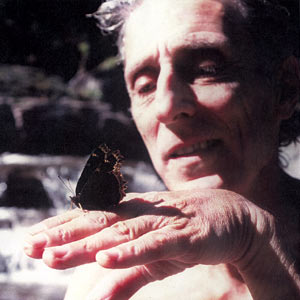 John came back to Woodstock, "hoping to become another Bob
Dylan and found out that I was not a songwriter, that I had to work
very hard at it. But I have never stopped writing songs because when
you get towards the end and you know that it's going to be a finished
song it's very exciting, one of the most thrilling things that can be
done and one of the most artistic things you can do as a musician,
writing your own music. And I've gotten a little action with that,
mostly through the song Stewball that Joan Baez and Peter Paul and
Mary recorded. And Jon the Generator, which Maria Muldaur recorded.
"Since then, I've had my own band called the John Herald Band, an
electric band for a while. I was lucky enough to train some people
who are much more famous than myself, including Larry Campbell, who's
been with Dylan, Cindy Cashdollar who's now getting very famous as a
lap steel and Dobro player, Gordon Titcomb, who's had a lot to do with
Arlo Guthrie and Paul Simon, I don't know exactly what. I believe I
was the first working band that they were in."
John came back to Woodstock, "hoping to become another Bob
Dylan and found out that I was not a songwriter, that I had to work
very hard at it. But I have never stopped writing songs because when
you get towards the end and you know that it's going to be a finished
song it's very exciting, one of the most thrilling things that can be
done and one of the most artistic things you can do as a musician,
writing your own music. And I've gotten a little action with that,
mostly through the song Stewball that Joan Baez and Peter Paul and
Mary recorded. And Jon the Generator, which Maria Muldaur recorded.
"Since then, I've had my own band called the John Herald Band, an
electric band for a while. I was lucky enough to train some people
who are much more famous than myself, including Larry Campbell, who's
been with Dylan, Cindy Cashdollar who's now getting very famous as a
lap steel and Dobro player, Gordon Titcomb, who's had a lot to do with
Arlo Guthrie and Paul Simon, I don't know exactly what. I believe I
was the first working band that they were in."
Three solo albums and a couple of John Herald Band recordings have
been released over the years and John continued to play in New York
City at the Parkside Lounge on Houston Street and has been a charter
member in the Woodstock Mountain Review, the large local collection
that includes Happy Traum, Bill Keith, Artie Traum, Jim Rooney, Roly
Salley, Cindy Cashdollar, Pat Alger, Eric Kaz and others. He even did
a stint as a country music disc jockey on WDST radio in 1980.
The John Herald Band "played most of the major folk festivals, and
quite a few bluegrass festivals. And this was the time I had the
longest band I ever had, consisted of Caroline Dutton on fiddle, Cindy
Cashdollar on Dobro, George Quinn on bass, and assorted banjo players,
Joe Deetz and another named Joe Val. Now, I have a band, but I don't
always use the exact same musicians. But I use the best musicians in
the northeast."
John had a lot of stories he had hoped to tell, reams of notes about
things like the time Chuck Berry told him how he loved Bill Monroe's
music, and that's how he wrote Memphis…or what he called the 'Garden
of Eden fun' of the Ashokan Clog and square dances where 15 to 35
people would get naked in the sauna and sing the Everly Brothers' Bye
Bye Love…or how he sold mushrooms he hunted to restaurants and
stores…or how the Greenbriar Boys boycotted Hootenanny television show
along with Dave Van Ronk, Billy Faier and Tom Paxton to protest that
the show wouldn't have Pete Seeger as a guest, and how the story was
on the cover of Billboard…or his short stint in the band The Flying
Machine, with James Taylor…about how Ralph Rinzler discovered Clarence
Ashley and Doc Watson and he used to stay with the Watsons when he was
in North Carolina…how he loved the guitar playing of Riley Puckett,
who played with Gid Tanner and the Skillet Lickers, and Arthur 'Guitar
Boogie' Smith…how he split the bill at the Gaslight with Bill
Cosby…how his great, great great great grandfather was John Greenleaf
Whittier…
The fame that John Herald sought did not ever materialize, but he
never gave an inch, never compromised a morsel for anyone. "I always
thought I was a little too folky for bluegrassers and a little too
bluegrassy for folk fans," he said. But it wasn't fame for fame's
sake, it was to share the joy of performing, the fruits of his hard
won songwriting, and the charm of his warm heart.
If ever by chance I should see you again
I won't pretend that I'm over you yet
I'll just reach out and touch you
In a way that you'll know
You're someone I'll never forget
Notes on the songs:
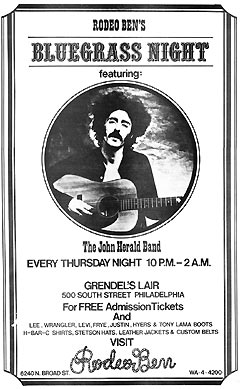 Bluegrass Boy
Bluegrass Boy
(John Herald, guitar, vocal; Gordon Titcomb, mandolin;
Roly Salley,
bass; John Sebastian, harmonica and vocal; Happy Traum, melodica; Andy
Robinson, vocals. Recorded 1977 at Bearsville Sound Studio, produced
by George James, Artie Traum, Happy Traum.)
John always said that he'd never sing this song as well again as on this recording, which
first appeared on the album Woodstock Mountains: More Music From Mud Acres. I'm sure people have different ideas when they think of John, but for me, this is always the song that pops into my head first. It flows so smoothly that you don't realize how beautifully crafted the song is, its slow descent down the guitar fingerboard drawing you in close for the payoff.
John also wanted to acknowledge a debt to Uncle Dave Macon on this song.
Single Life
(John Herald, lead and rhythm guitar, vocal; Rob Stein, lead
guitar; Mindy Jostyn, concertina. Recorded mid-1990s at Bearsville
Studio, Mark McKenna, engineer.)
John went through a lot of titles for this song of loneliness and
longing, never quite being satisfied with its name until relatively
recently.
Moneyland
(John Herald, guitar, vocal; Rob Stein, guitar; Mindy Jostyn,
banjomandolin
Recorded mid-1990s at Bearsville Studio, Mark McKenna, engineer.)
The sharp political edge on this song reflects John's identification
the have-nots of the world who struggle to earn a living, and
sometimes rise up to fight the power. George Quinn said it best - "He
wanted to go back to America in the 1930s. The era of the Great
Depression and union activism. He was from the Pete Seeger school of
music - justice songs, anti-corporate, Worker's parties…"
You can buy a judge or a bribe or a thug or a bomb or a shredding
machine
You can buy your way through or into and onto any ticket or TV
machine,
it's a money disease
It's a thing called greed; and it feeds on those who need the money most in Moneyland
Hats Off To The Cajun Moon
(John Herald, guitar, vocal; Greg Garing, mandolin, fiddle; Eric
Weissberg, bass. Recorded mid-1990s at Bearsville Studio, Mark
McKenna, engineer.)
Just beautiful.
In the mid 1990s, Sally Grossman gave John some time in the Bearsville Studios, with Mark McKenna and Chris Laidlaw engineering. And Charles Lyonhart helped with the production. Those sessions make at least half of this album.
Working It Out By Walking It Off
(John Herald, guitar, vocal; Bill Keith, banjo; Jay Ungar, fiddle;
Brian Hollander, Dobro; George Quinn, bass. Recorded June, 2005,
Nevessa Studio, Woodstock)
Cut at John's last recording session where he sounded as good as ever.
The most bluegrass-sounding tune on the CD, featuring beautiful work
from the great Bill Keith on banjo and Jay Ungar on fiddle, it also
features some of John's soaring vocal swoops and yodels.
Still Got It Bad
(John Herald, guitar, vocal; Cindy Cashdollar, Dobro; Caroline
Dutton, fiddle; George Quinn, bass. Recorded live at Joyous Lake,
Woodstock, May 26, 1983, by Chris Andersen in Nevessa Remote Truck No.
1)
A long, live night at the Lake in 1983 yielded a release called Bring
It On Down To My House, that had life as a cassette but never made it
to the CD era. This was the classic John Herald Band, unelectricfied
version, with Cindy Cashdollar and Caroline Dutton teaming with John
and George Quinn. Joe Deetz was the banjo player in the band on the
album. But this song, one of John's most lovely aching ballads, had
no banjo.
The Bond
(John Herald, guitar, vocal; Eric Weissberg, Dobro; Greg Garing,
Fiddle; Trip Henderson, harmonica; George Quinn, bass. Recorded
mid-1990s at Bearsville Studio, Mark McKenna, engineer.)
This one is for Charles.
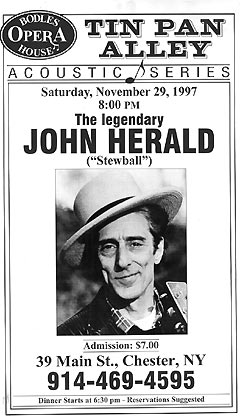 Don'cha Cadillac Me
Don'cha Cadillac Me
(John Herald, guitar, vocal; Jay Ungar, mandolin; George Quinn, bass
Recorded June, 2005, Nevessa Studio, Woodstock)
Written as it is sung here, John was nervous that General Motors would
land an SUV on his head for denigrating their flagship. So he cut
various versions in which he'd substitute 'limousine' for Cadillac.
But nothing works so well as a Cadillac...y'hear that General
Motors…
Martha (The Last Passenger Pigeon On Earth)
(John Herald; guitar, vocal; Cindy Cashdollar, Dobro; Caroline
Dutton, fiddle; George Quinn, bass.
Recorded live at Joyous Lake, Woodstock, May 26, 1983.)
John's Tour de Force, tying history, emotion, metaphor into this
compelling tale. Yes, John, a piece of us all does go with you…
Queen Of Spoons
(John Herald, guitar, vocal; Rob Stein, guitar
Recorded mid-1990s at Bearsville Studio, Mark McKenna, engineer.)
Who was she?
Flock Of Flamingos
(John Herald, guitar and vocal; Trip Henderson, harmonica; George
Quinn, bass
Recorded mid-1990s at Bearsville Studio, Mark McKenna, engineer.)
Sort of 'Blues in a Bottle' turned upside down. Trip's harp and
John's great guitar solo propel this one along.
Special Magic
(John Herald, guitar, vocal; Jay Ungar, fiddle; Guy 'Fooch' Fishetti,
fiddle; George Quinn, bass. Recorded June, 2005, Nevessa Studio,
Woodstock)
Jay Ungar and Fooch provide a lush double-fiddle cushion for John's
remembrance of a love that had it.
Jon The Generator
(John Herald, guitar, vocal; Cindy Cashdollar, Dobro; Caroline
Dutton, Fiddle, Charlie Sayles, harmonica; Joe Deetz, banjo; George
Quinn, bass Recorded live at Joyous Lake, Woodstock, May 26, 1983.)
John reworked and rewrote the Blind Willie Johnson call-and-response spiritual because he couldn't find the words. It became his own classic, dangling audie nces with its electricity and ultimately expressing a great optimism, reminding us how People don't like the habit, Of mistrusting each other
This doesn't have to be the last John Herald album. There is much
more material that can be culled and shaped into future projects. But
for now, this one will have to do. Here's to you, John.
Brian Hollander
Woodstock, New York
August, 2005
Produced by John Herald and Brian Hollander for Sam Hood Management
Design: Megan Denver
Production: Tod Levine, Magnetic North
Disc mastering: Tom Mark, Make Believe Ballroom
Photos by Holly Wilmeth
Special thanks to Robbie Dupree, Artie Traum, Kurt Henry, Charles
Lyonhart, Diane Chetta, Dan Schneider, John Sebastian, Charlotte Pfal,
Happy Traum, Steve Stiert, Jay Ungar, George Quinn, Kim Chalmers
Herald and the Thursday Committee.

 "Pete Seeger had come to one camp, Woodland, which is up in Phoenicia.
He said, well I don't care if you can't carry a tune with a
wheelbarrow, just let loose and you might be singing in a harmony, it
doesn't matter. I didn't know much about folk music at the time. I'd
heard about it, my father had taken me to different functions at which
I'd heard Leadbelly and Woody Guthrie.
"Pete Seeger had come to one camp, Woodland, which is up in Phoenicia.
He said, well I don't care if you can't carry a tune with a
wheelbarrow, just let loose and you might be singing in a harmony, it
doesn't matter. I didn't know much about folk music at the time. I'd
heard about it, my father had taken me to different functions at which
I'd heard Leadbelly and Woody Guthrie.

 John came back to Woodstock, "hoping to become another Bob
Dylan and found out that I was not a songwriter, that I had to work
very hard at it. But I have never stopped writing songs because when
you get towards the end and you know that it's going to be a finished
song it's very exciting, one of the most thrilling things that can be
done and one of the most artistic things you can do as a musician,
writing your own music. And I've gotten a little action with that,
mostly through the song Stewball that Joan Baez and Peter Paul and
Mary recorded. And Jon the Generator, which Maria Muldaur recorded.
"Since then, I've had my own band called the John Herald Band, an
electric band for a while. I was lucky enough to train some people
who are much more famous than myself, including Larry Campbell, who's
been with Dylan, Cindy Cashdollar who's now getting very famous as a
lap steel and Dobro player, Gordon Titcomb, who's had a lot to do with
Arlo Guthrie and Paul Simon, I don't know exactly what. I believe I
was the first working band that they were in."
John came back to Woodstock, "hoping to become another Bob
Dylan and found out that I was not a songwriter, that I had to work
very hard at it. But I have never stopped writing songs because when
you get towards the end and you know that it's going to be a finished
song it's very exciting, one of the most thrilling things that can be
done and one of the most artistic things you can do as a musician,
writing your own music. And I've gotten a little action with that,
mostly through the song Stewball that Joan Baez and Peter Paul and
Mary recorded. And Jon the Generator, which Maria Muldaur recorded.
"Since then, I've had my own band called the John Herald Band, an
electric band for a while. I was lucky enough to train some people
who are much more famous than myself, including Larry Campbell, who's
been with Dylan, Cindy Cashdollar who's now getting very famous as a
lap steel and Dobro player, Gordon Titcomb, who's had a lot to do with
Arlo Guthrie and Paul Simon, I don't know exactly what. I believe I
was the first working band that they were in."
 Bluegrass Boy
Bluegrass Boy
 Don'cha Cadillac Me
Don'cha Cadillac Me